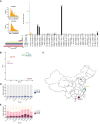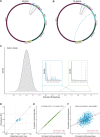Searching across-cohort relatives in 54,092 GWAS samples via encrypted genotype regression
- PMID: 38206971
- PMCID: PMC10783776
- DOI: 10.1371/journal.pgen.1011037
Searching across-cohort relatives in 54,092 GWAS samples via encrypted genotype regression
Erratum in
-
Correction: Searching across-cohort relatives in 54,092 GWAS samples via encrypted genotype regression.PLoS Genet. 2024 Feb 21;20(2):e1011149. doi: 10.1371/journal.pgen.1011149. eCollection 2024 Feb. PLoS Genet. 2024. PMID: 38381719 Free PMC article.
Abstract
Explicitly sharing individual level data in genomics studies has many merits comparing to sharing summary statistics, including more strict QCs, common statistical analyses, relative identification and improved statistical power in GWAS, but it is hampered by privacy or ethical constraints. In this study, we developed encG-reg, a regression approach that can detect relatives of various degrees based on encrypted genomic data, which is immune of ethical constraints. The encryption properties of encG-reg are based on the random matrix theory by masking the original genotypic matrix without sacrificing precision of individual-level genotype data. We established a connection between the dimension of a random matrix, which masked genotype matrices, and the required precision of a study for encrypted genotype data. encG-reg has false positive and false negative rates equivalent to sharing original individual level data, and is computationally efficient when searching relatives. We split the UK Biobank into their respective centers, and then encrypted the genotype data. We observed that the relatives estimated using encG-reg was equivalently accurate with the estimation by KING, which is a widely used software but requires original genotype data. In a more complex application, we launched a finely devised multi-center collaboration across 5 research institutes in China, covering 9 cohorts of 54,092 GWAS samples. encG-reg again identified true relatives existing across the cohorts with even different ethnic backgrounds and genotypic qualities. Our study clearly demonstrates that encrypted genomic data can be used for data sharing without loss of information or data sharing barrier.
Copyright: © 2024 Zhang et al. This is an open access article distributed under the terms of the Creative Commons Attribution License, which permits unrestricted use, distribution, and reproduction in any medium, provided the original author and source are credited.
Conflict of interest statement
The authors have declared that no competing interests exist.
Figures







References
MeSH terms
LinkOut - more resources
Full Text Sources

